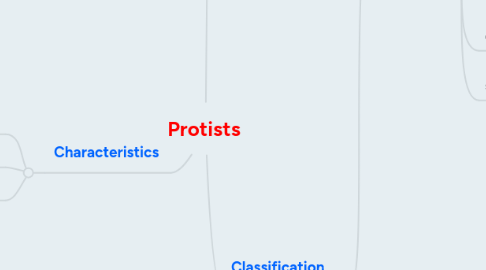
1. Characteristics
1.1. eukaryotic
1.2. one or many celled
1.3. moist/wet suuroundings
2. Classification
2.1. fungus-like
2.1.1. evolved into fungi
2.1.2. parasite
2.1.3. saprophyte
2.1.4. slime molds
2.1.4.1. digestion takes place outside the body
2.1.4.2. pseudopods
2.1.4.3. saprophytic
2.1.4.3.1. logs/dead leaves
2.1.4.3.2. moist/cool/shady places
2.1.5. water molds
2.1.5.1. parasite
2.1.5.2. attack living organisms
2.1.6. downy mildew
2.1.6.1. attack plants
2.1.6.1.1. weaken
2.1.6.1.2. kill
2.1.7. spores
2.1.7.1. flagella
2.2. animal-like (protozoans)
2.2.1. can move
2.2.2. Evolved into simple animals
2.2.3. cilliates
2.2.3.1. have cilia
2.2.3.2. little hairs
2.2.3.3. oars
2.2.3.4. paramecium
2.2.3.4.1. oral groove
2.2.3.4.2. endocytosis
2.2.3.4.3. contractile vacuoles
2.2.4. flagelates
2.2.4.1. move with flagella
2.2.4.2. termite
2.2.4.2.1. stomach
2.2.4.3. sponge
2.2.4.3.1. filter feeders
2.2.5. pseudopods
2.2.5.1. false foot
2.2.5.2. trapped with
2.2.5.2.1. endocytosis
2.2.5.3. some are shelled
2.2.6. cannot move
2.2.6.1. most likely parasite
2.2.6.2. malaria
2.2.6.3. African sleeping disease
2.2.6.3.1. carried by Tsetse flly
2.3. plant-like (algae)
2.3.1. bloom
2.3.1.1. red tide
2.3.1.1.1. dangerous
2.3.1.2. influx of nutrients
2.3.2. Evolved into simple plants
2.4. euglenoid (plant-animal-like)
3. Reproduction
3.1. mitosis
3.1.1. genetically identical
3.1.2. asexual
3.2. meiosis
3.2.1. genetically variant
3.2.2. sexual

